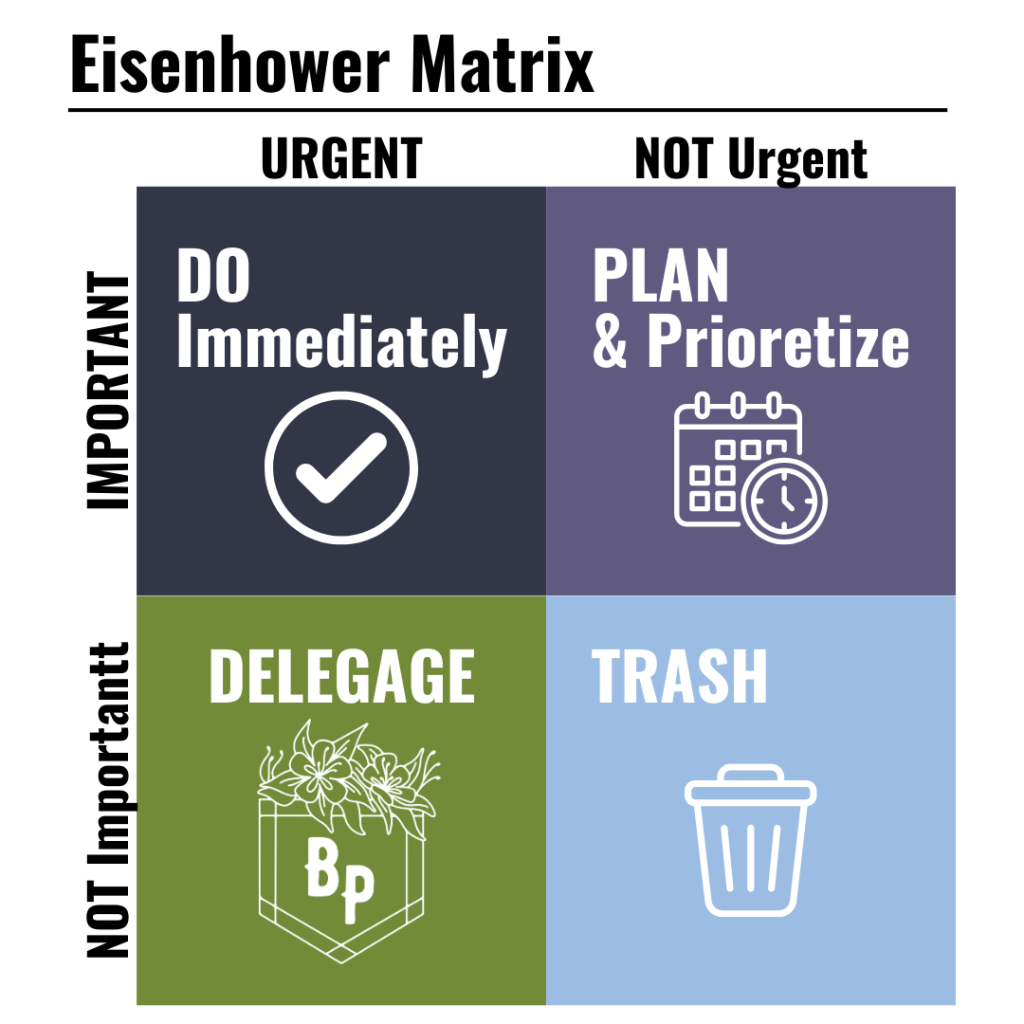Do you ever feel like your to-do list is running your life? You’re not alone. Balancing what needs to be done right now versus what can wait is one of the biggest challenges for professionals and business owners. That’s where the Eisenhower Matrix comes in—a simple yet powerful tool to help you prioritize and make the most of your time.
What Is the Eisenhower Matrix?
The Eisenhower Matrix, also known as the Urgent-Important Matrix, is a productivity framework developed by Dwight D. Eisenhower, the 34th President of the United States. Known for his efficiency in decision-making, Eisenhower famously said:
“What is important is seldom urgent, and what is urgent is seldom important.”
The matrix categorizes tasks based on two factors:
- Urgency: Does it require immediate attention?
- Importance: Does it contribute to your long-term goals or values?
By dividing tasks into these categories, you can determine what needs your attention right now and what can be delegated, scheduled, or eliminated altogether.

How Does It Work?
The Eisenhower Matrix is a 2×2 grid with four quadrants:
1. Quadrant 1: Urgent and Important (Do First)
These are your critical tasks—things that must be addressed immediately because they have serious consequences if delayed.
Examples:
- Responding to a client emergency
- Meeting a deadline
- Handling a health crisis
Action: Do these tasks right away. They are top priority.
2. Quadrant 2: Not Urgent but Important (Schedule)
These tasks contribute to your long-term goals and overall success but don’t need immediate action. Unfortunately, they’re often neglected because they don’t demand your attention.
Examples:
- Strategic planning
- Building relationships
- Learning new skills or professional development
- Health and wellness routines
Action: Schedule time to focus on these tasks. They are essential for preventing crises and fostering growth.
3. Quadrant 3: Urgent but Not Important (Delegate)
These tasks feel urgent but don’t necessarily require your expertise or personal involvement. They can often be delegated to someone else.
Examples:
- Interruptions like phone calls or emails
- Administrative tasks
- Routine reports
Action: Delegate these tasks to a capable team member or virtual assistant. Freeing up your time for more critical work is key.
4. Quadrant 4: Not Urgent and Not Important (Eliminate)
These are time-wasters that don’t add value to your life or work.
Examples:
- Mindless scrolling on social media
- Excessive TV or entertainment
- Unnecessary meetings
Action: Eliminate these tasks. Be ruthless in cutting out distractions that don’t serve your goals.
How to Use the Eisenhower Matrix
- List Your Tasks: Write down everything you need to do—big or small.
- Categorize Each Task: Place each item into one of the four quadrants based on its urgency and importance.
- Take Action:
- Quadrant 1: Complete immediately.
- Quadrant 2: Schedule for later.
- Quadrant 3: Delegate to someone else.
- Quadrant 4: Eliminate entirely.
Benefits of Using the Eisenhower Matrix
- Clarity: It forces you to evaluate what truly matters.
- Focus: Helps you spend your time on important tasks, not just urgent ones.
- Efficiency: By delegating and eliminating unnecessary tasks, you can focus on what only you can do.
- Reduced Stress: With a clear plan, you’ll feel more in control of your workload.
Real-Life Example
Imagine you’re a business owner with the following tasks:
- Responding to a customer complaint (Quadrant 1)
- Creating a marketing strategy for the next quarter (Quadrant 2)
- Filing receipts for expenses (Quadrant 3)
- Watching a random webinar that caught your attention (Quadrant 4)
By using the Eisenhower Matrix, you’d prioritize the customer complaint first, schedule time for the marketing strategy, delegate the receipt filing, and skip the webinar.
Start Prioritizing Today
The Eisenhower Matrix is more than just a time-management tool—it’s a mindset shift. It helps you focus on what truly matters and let go of the distractions that don’t. Whether you’re managing a business, a team, or just your daily to-dos, this framework can help you achieve more with less stress.
Ready to take back control of your time? Grab a piece of paper, draw your grid, and start categorizing your tasks. The clarity it brings might just change the way you work.


